Ecommerce returns can be a disease—aggressively attacking profit margins, gutting conversion rates, and ultimately threatening your business.
Collectively, consumers returned products worth a staggering$817 billion—just over 16% of total retail sales. The National Retail Federation estimates the cost of returns amounts to$101 billion.
It paints a bleak portrait, especially for online retailers. But the real cost driver is this: Many customers buy with an explicit plan to immediately return some or all of their items.
In response, businesses are adding workers, increasing warehouse space, and establishing separate departments to handlereverse logistics. Returns are the new normal and central to customer experience. But they don’t have to be a plague.
In fact, how you deal withecommerce storereturns—before and after purchase—can differentiate your brand, create a competitive advantage, and even make you more profitable.
Table of Contents:
- The state of ecommerce returns
- Strategies for handling ecommerce returns
- The best software for handling ecommerce returns
- Ecommerce returns best practices
The state of ecommerce returns
Ecommerce return rates by industry
Ecommerce returns happen across all industries. It’s become a necessary evil for retailers.
In fact, reducing customer returns and lost sales from returns has become one of themain business prioritiesamongst retailers, as of 2022. (That supports why almosteight in 10 retailersin the US had already incorporated, or plan to incorporate, returns processing technology.)
TheNational Retail Federation reportsthat for every $1 billion in sales, the average retailer incurs $165 million in merchandise returns. Plus, for every $100 in returned merchandise accepted, they lose $10.40 to return fraud.
In the NRF’s 2022 survey, the expectation of fraud, even when a receipt is present, jumped 43% year over year, to 14% from 9.8%.
When asked about the most returned purchases by category, 26% of consumers chose clothing as their answer, followed by bags and accessories (19%) and shoes (18%).
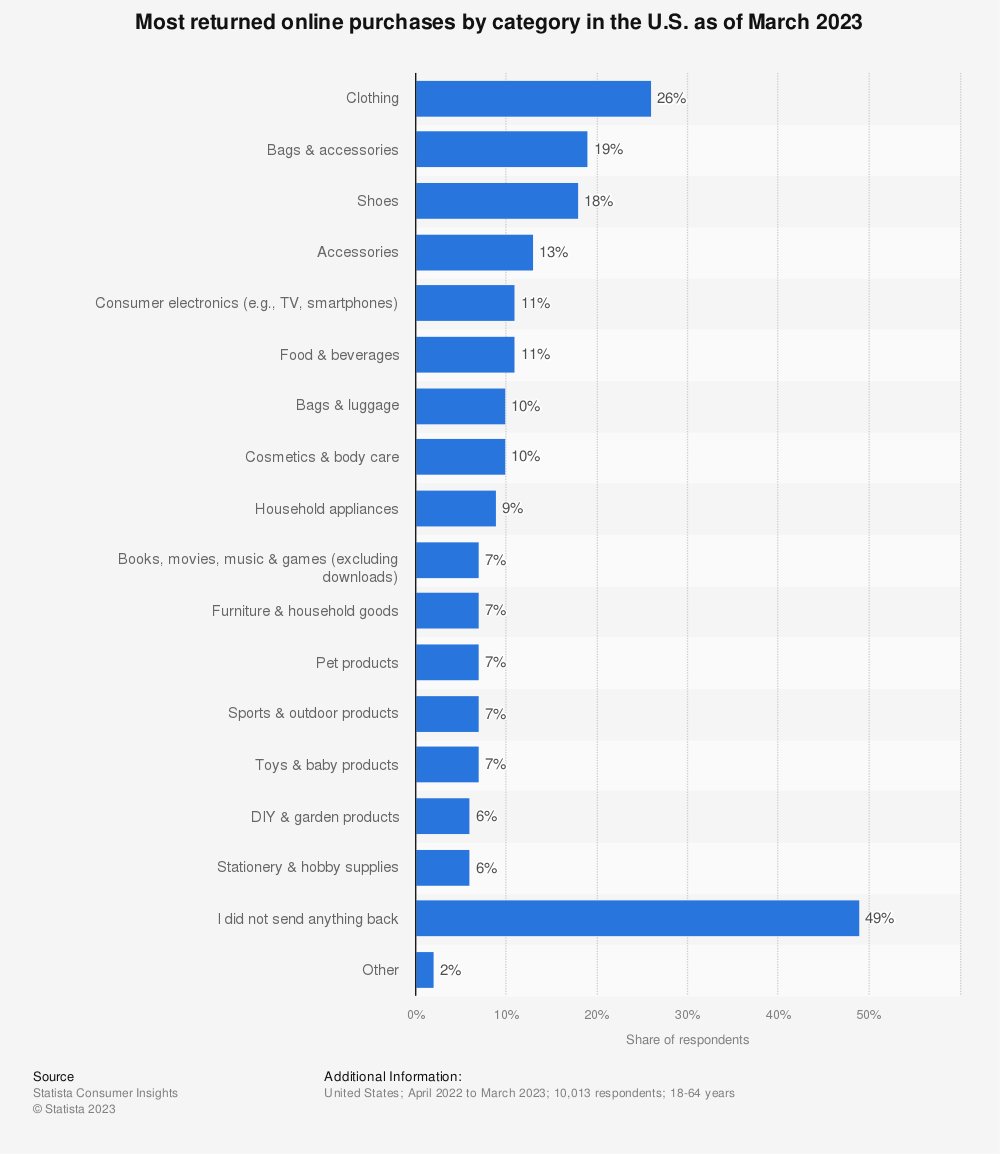
Statista
Why do people return items?
When asked why they returned items,PowerReviews foundthat 81% of online shoppers said the item was damaged or defective. Other reasons include:
- Item doesn’t fit (75%)
- Item doesn’t match description (56%)
- Don’t like the item(s) (33%)
- Ordered multiple items/sizes (14%)
- Item arrived late (11%)
Ecommerce returns and the holiday season
Unsurprisingly, the number of returns mirrors peak ecommerce sales periods. The holiday season, for example, is the most popular time of year for online shopping. In 2022, holiday online salesreachedover $240 billion.
On average, holiday return rates huddle around17.9%each year. Whether it’s gifts a friend doesn’t like or trying to reclaim some money they spent in a holiday-inspired splurge, it’s why ecommerce brands receive the most returns throughout December, January, and February.
The impact of returns on customer loyalty
When people do decide to return their online purchases, most retailers opt to refund the purchase price to a customer post-return. Some offer exchanges; the same number give a gift card to redeem on a future purchase.
Regardless of which refund type a retailer is offering, there are strong customer expectations to compete with. But put a foot wrong in this return experience and you’ll add a hurdle in your mission toward getting repeat customers. Data showsnearly 80%of US online shoppers are less likely to shop from the same retailer again due to a poor returns experience.

Statista
Get the returns experience right and customers will return to buy again. You’ll make future purchase decisions easier and increase customer lifetime value.
Strategies for handling ecommerce returns
Post the item back to your warehouse
This is the most popular returns process forecommerce-only brands without a brick-and-mortar store. When a customer wants to return an item they’ve bought online, they post it back to your warehouse or fulfillment center. From there, the merchandising department inspects the product and confirms it’s eligible for a refund.
Retailers can save time on manual returns with return management apps. They speed up the process, give customers a status of their return, and update yourinventory management systemautomatically (more on that later).
Return items to store
If you have a retail store, consider allowing ecommerce customers to visit it to return their item. The returned goods can then be inspected and put back on the shelf for future customers.
Not only are store returns more convenient, but enticing customers to enter a store could prevent future returns. If a customer is returning a t-shirt that doesn’t fit, for example, they’ll have the opportunity to try on other sizes during their visit. That gives them more confidence in future purchase decisions—both online and offline—because they know their size.
Outsource reverse logistics
Returns management is a lengthy process. But it’s one you don’t have to handle in house.Third-party logistics(3PL) partners handle the entire order fulfillment process—including returns. A provider offeringreverse logisticsstores a retailer’s inventory in a third-party warehouse.
When customers return an item the 3PL has previously shipped, it arrives back at their warehouse. Their team inspects the item and processes a refund. The approved returned item is then put back on the shelf to be picked for another order.
Best software for handling ecommerce returns
Brands can handle ecommerce returns by using one of the manyreturns and exchanges appsavailable in the Shopify App Store. These apps track and fulfill orders, get your products out the door, and protect your business from risky transactions.
Across all Shopify businesses, 65% of refunds are performed manually, the remaining 35% via apps. Here are three of the most popular.
Happy Returns
Happy Returnsis an ecommerce returns management software used by retailers like Rothy’s, Everlane, and Andie.
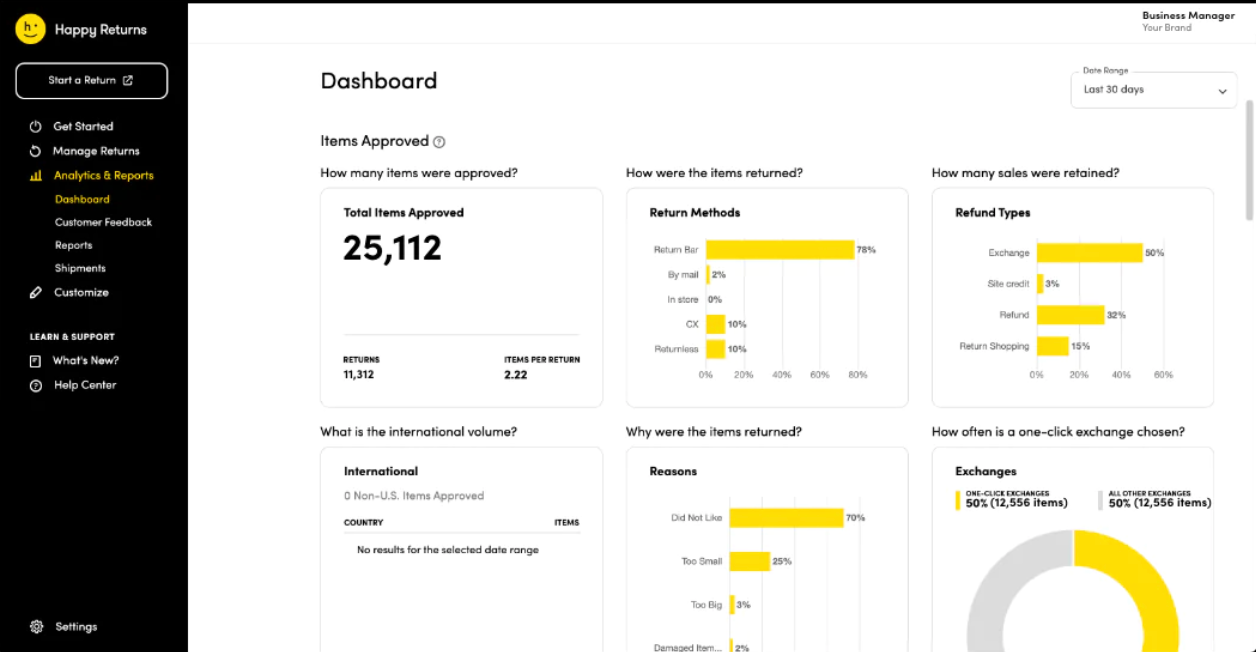
Sanaz Hajizadeh, Happy Returns’ director of product management, says, “Happy Returns offers box-free returns for online merchants through a combination of software andreverse logistics—pioneering in-person, aggregated returns that can help dramaticallyreduce shipping costsand the impact on the planet.
“快乐覆盖售后的所有方面: from tracking orders as they are fulfilled to providing flexible return options for merchants, no matter where their warehouse and shoppers are located.”
In addition to its returns software, Happy Returns also provides buy online, return in-store and mail returns services for hundreds of leading merchants. It maintains a network of more than 2,600 Return Bar locations where online shoppers can drop off their returns in person.
“Every merchant should focus on selling and increasing revenue,” says Sanaz. “By using tools that automate the post-purchase process, they can reduce operational headaches. Of course, merchants can use one tool for each task, but combining them in one powerful tool makes it easier to gather data, manage their return policy, and keep everything seamless and on-brand.”
Loop
Loopis another returns management tool for Shopify Plus sites. Customers submitting a return are incentivized to exchange the item, rather than return it. They can exchange an item for another size or color in one click.
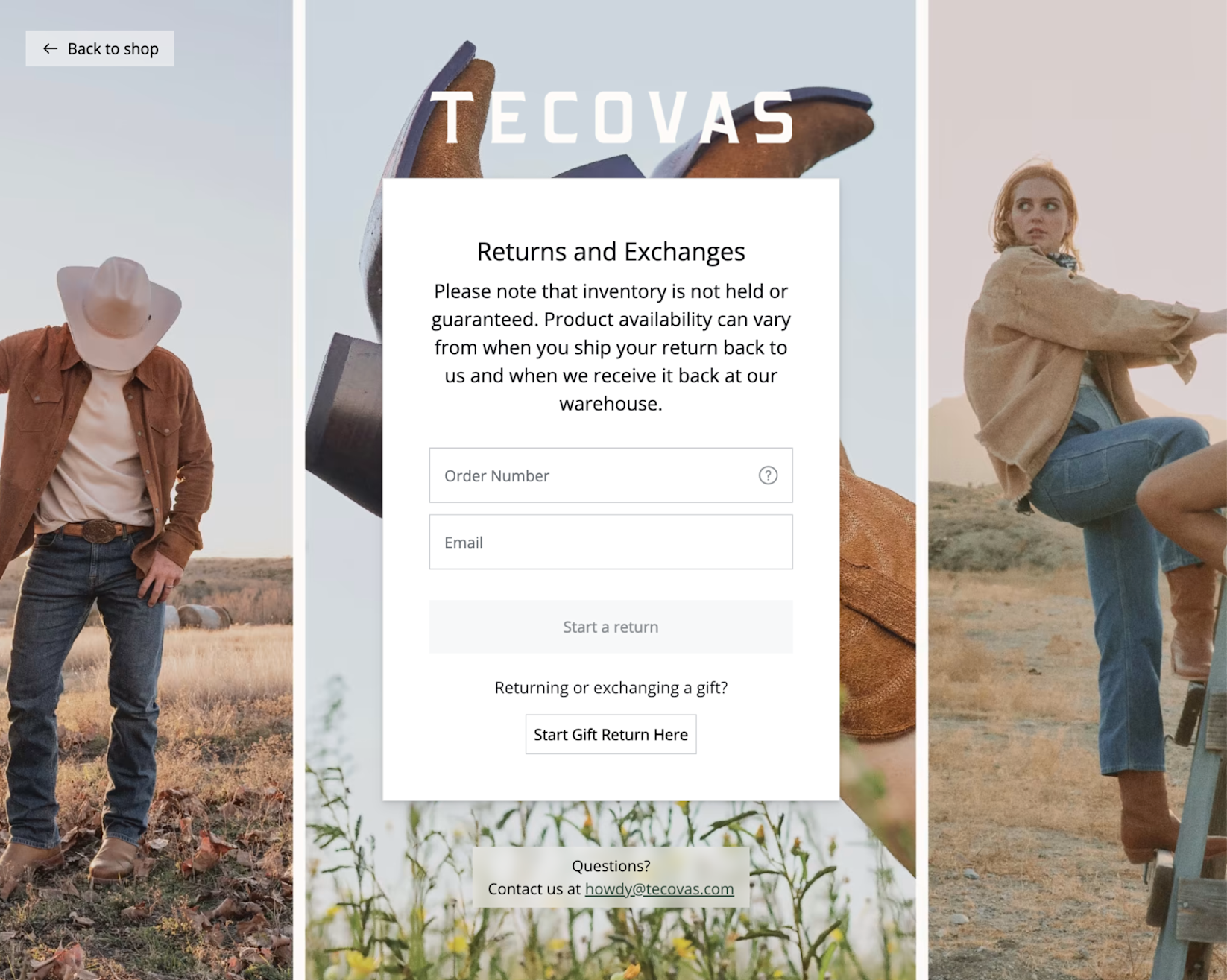
Tecovas uses Loop to manage ecommerce returns.
Should a customer still want a refund for their purchase, Loop helps retailers streamline their returns process. It uses data from a returns form and your returns policy to automatically approve or deny requests.
"We like Loop because it is incredibly user friendly, so it’s super easy for customers to return items,” says Lanai Moliterno, founder ofSozy. “We like this because it makes us look good and lets the customer leave with a positive experience. Because of the way that it’s set up, it makes it easy to swap out returns for other products in our shop, which helps keep the customer and the money.”
Returnly
If you’re managing ecommerce returns from international customers,Returnlyis a solid option. It automatically creates return labels to get packages through customs. Shoppers can also request refunds (or credit) in their local currency.
Not only that, itsGreen Returns programhelps retailers reduce waste. It makes real-time decisions based on a retailer’s returns policy to judge whether an item can be resold if returned. If it can’t, the customer doesn’t need to waste their time shipping it back. Fewer shipments mean less waste, cheaper shipping costs, and better customer experiences.
Ecommerce returns best practices
Now we know the process for handling ecommerce returns and the options available to you, there are still things you can do to reduce the number of returns you’re handling. (That’s the end goal, after all. Fewer returns means happier customers and more revenue.)
Here are six ecommerce returns best practices to boost efficiency and cut costs.
Make product information accurate and easy to find
It’s standard practice to check that all public-facing content—including product descriptions—are accurate and detailed. If the product arrives differently than expected, there’s a high chance of it being returned.
To reduce returns andimprove conversions, make sure the following information is included on every product page across yourecommerce site:
- Product weight and dimensions
- Materials used to make the product
- Size guides,including the size a model is wearing (if appropriate)
- Your ecommerce returns policy(i.e., how long they have to return an item, any costs associated with it, and the types of product eligible for return)
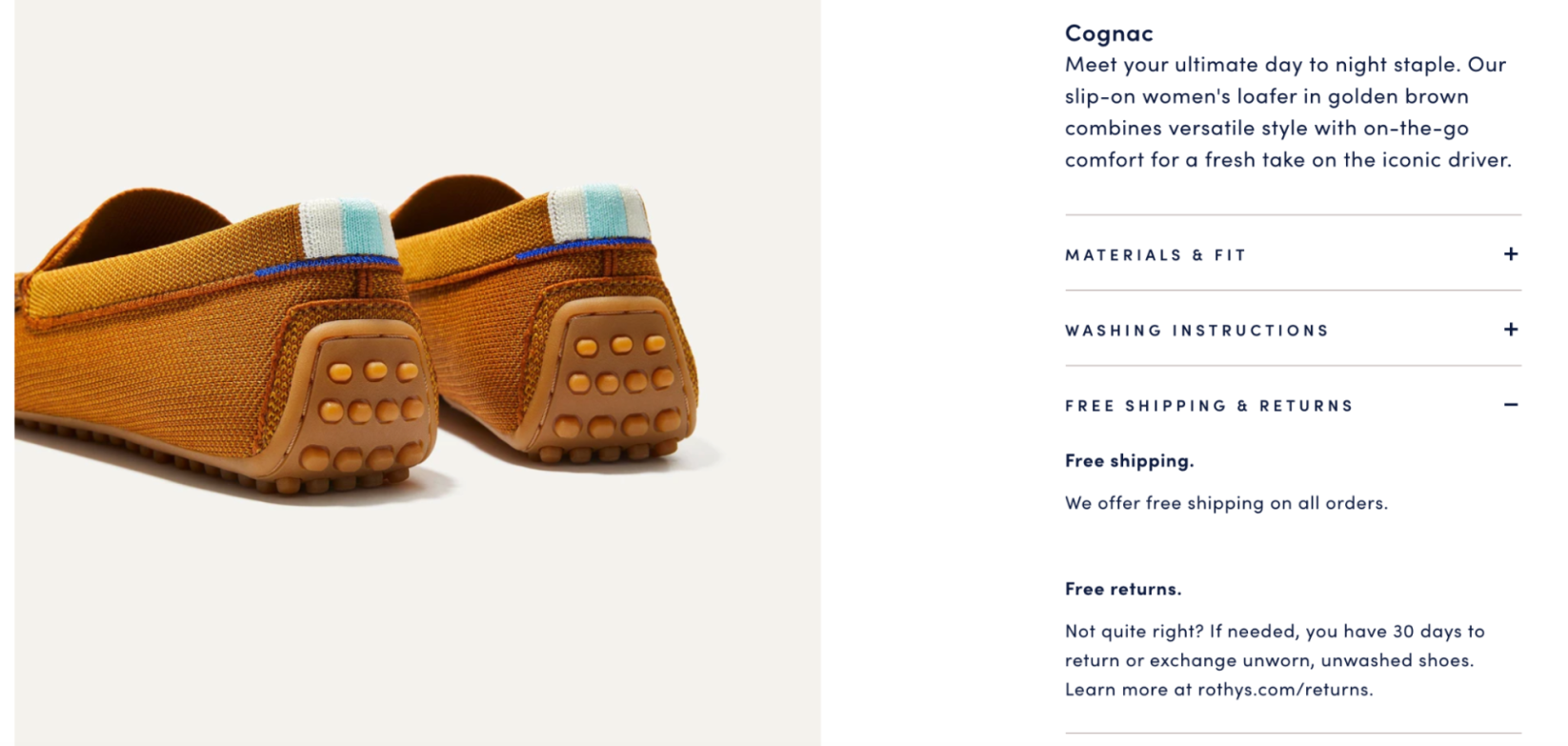
Rothy’shighlights its returns policy on each product page to increase conversions and prevent returns.
TakeSupplement Warehouse, for example. It ships 300 supplement packages daily through its warehouse, all of which are ordered through its ecommerce store. Its former marketing manager, Brian Anderson, explains that most people return their items because customers didn’t notice that their product contained a specific ingredient.
“Because we sell vitamins and supplements, many people order the product and wait until they have it in hand to review all of the ingredients,” says Brian. Some are allergic or their doctor told them not to take it, so they end up returning it. We have made sure that all product labels are large and visible on product pages. This makes it easier for potential customers to read the label before they purchase.”
Automation helps solve most of these issues. Use plug-ins likeLow Stock Alertto see when items are running low. This prevents you from selling an item that isn’t available—and shipping the wrong item in its place.
According to Josh Wayne, VP of commerce products atTrueCommerce, “A lot of brands try to manage all their product information manually, and with ecommerce channels growing so rapidly, it’s just not feasible to avoid mistakes that way.
“What ends up happening is, a customer orders a product, and when it arrives, it’s the wrong color or size or compatibility, because there was incorrect or missing information online. It’s an immediate return, and can also result in low ratings and reviews, which impact future sales,” Wayne adds.
Use 3D/AR on your ecommerce website
Shopping in-store naturally has some advantages over shopping online. Amongst the biggest is the ability to see, try on, and interact with products before a customer decides to buy it.
Augmented reality (AR) technology helps online shoppers experience the same thing. Retailers can use it to show what their products look like tried on, in a customer’s home, or next to an item they own for a size comparison.
Gunner Kennels, for example, uses augmented reality and 3D technology on its ecommerce store. It knew it would be difficult for customers to see the size of a dog crate and whether their pet would fit inside it—which would inevitably lead to returns.
With the help of Shopify Plus, Gunner Kennels developed 3D models of its crates. “With this technology, buyers can now use their device to place the crate right next to their dogs to confirm sizing, decreasing our return rate by 5%,” says Macey Benton, VP of marketing at Gunner Kennels. “We would like to use this feature on future products and other accessories moving forward.”
The retailers’ investment in 3D and AR technology paid dividends:
- Return rate reduced by 5%
- Cart conversion rate increased by 3%
- Order conversion rate increased by 40%
Learn more:Augmented Reality in Ecommerce: How AR, VR, and 3D Are Changing Online Shopping
Pack and ship items securely
It’s easy to think that once an item has left your warehouse, it’s off your plate. The truth is, some items are returned because they arrived faulty or damaged. But you wouldn’t ship them in that state. Something went wrong in transit.
Granted, your delivery carrier plays a big role in this. But there are steps you can take to minimize the chances of an item becoming broken or faulty through shipping—and therefore, being returned:
- Inspect every item of clothing before it’s dispatched to a customer
- Use protective material, such as bubble wrap, in a delicate package
- Add Fragile labels to parcels with easily breakable items inside (like glass)
- Use the correct parcel size so items don’t jolt around in transit
Make your returns process sustainable
Most companies’ return processes don’t fit the sustainability bill. It’s estimated that the fashion industry alone is responsible for10%of global carbon emissions.
Preventing the likelihood of returns help to reduce your ecommerce brand’s carbon footprint. The fewer packages that come your way, the less fuel and resources you use.
Unfortunately, you’ll still deal with returns. Make sure your ecommerce return policy ismore sustainableby ditching the prepackaged free-return labels in your parcels. Printing those labels—even for customers who don’t need them—is wasteful. Instead, ask customers to go online and print their own labels when needed.
Keep customers informed about the status of their return
For ecommerce businesses, brand perception and reputation is everything. Just one tweet like this can influence another customer’s decision to purchase from you or a competitor:
当评估最重要的问题your reverse logistics process is whether or not you’re designing and optimizing the experience for the customer or for your business—ideally, it’s a mix of both.
When in doubt, default to the customer. First, keep them up to speed on the returns process while in the flow, either by email or, preferably, via Facebook Messenger or SMS. If your OMS facilitates this, incredible. Second, get feedback and ratings on the returns process itself—that’s where you’ll find gold nuggets to set yourself apart from the competition.
Find a shipping carrier that supplies tracking information. Most offer tracking numbers for customers to see the location of their returned parcel. Once it arrives at your warehouse, send the customer an automated message to confirm you’ve got it. Give them an ETA on how long they should expect to wait for a refund.
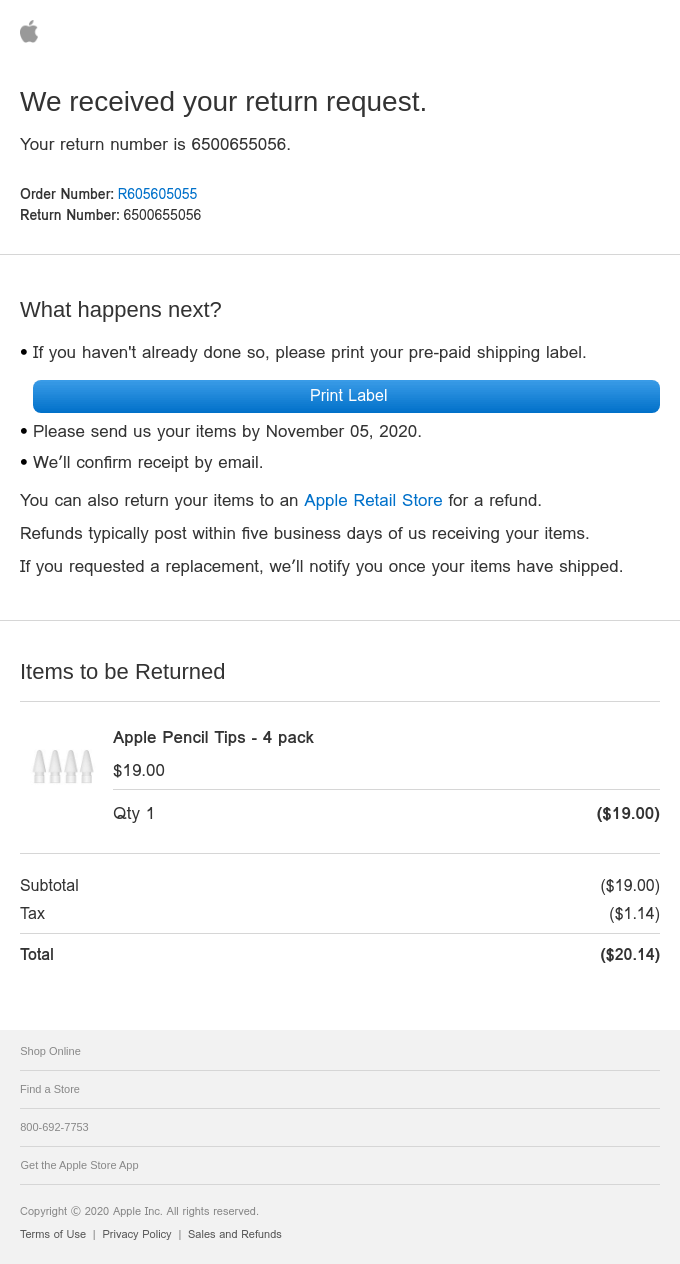
Apple’s return confirmation email. Source: Really Good Emails
Protect your business against ecommerce return fraud
Did you know that for every $100 in returned merchandise, retailerslose $10.30to return fraud? Fraudulent return requests cause the biggest losses for13% of all retailers, which is why return fraud has become more of a priority for retailers.
It’s crucial to separate the types of returners and track them automatically. A tool likeShopify Flowcan help. Establishrefund thresholdsbased on per-order dollar values or the number of returned items. Second, use that threshold to automatically:
- Tag customers for identification and segmentation
- Notify your customer service team via email or Slack to investigate
- Add those customers as a segment within an onsite personalization tool to exclude them fromfree shippingand/or full-refund offers
- Exclude them from free shipping at checkout by creating ashipping scriptbased on one or more of your customer tags
Some retailers—includingAmazonandASOS—are reportedly updating their returns policy to blacklist serial returners. While extreme, such actions are often necessitated by the first type of habitual returner.
If blacklisting customers isn’t an option for your ecommerce business, there are other things you can do to prevent return fraud:
- Choose a delivery carrier that supplies tracking numbers or proof of delivery.For example, a photo inside a customer’s open doorway.
- Substitute cash refunds for exchanges or store credit.There’s less incentive for someone to try and return a stolen item if they’re getting a like-for-like back.
- Offer a longer exchange window than you do for a refund.This ensures your customer still has ample time to return but makes an exchange more likely.
- Ditch free return shippingto make it harder for fraudsters to push their luck with return fraud.
- Only process returns if the item comes with a receipt or proof of purchase.This prevents people from returning stolen merchandise or items purchased from another retailer. You’ll also see the exact amount they paid for the item to process a refund.
- Don’t accept returned items of clothing without the original tag or protective seal.This prevents wardrobing: when a customer wears an item and returns it as if it were new.
Ecommerce returns are inevitable, but manageable
With over16%of all online purchases eventually diverting back toward the retailer’s warehouse, ecommerce returns aren’t something you can ignore.
Do everything you can to prevent returns—from writing accurate product descriptions to picking and packing items securely.
Remember that a small number of returns is inevitable. When it happens, keep customers informed about the status of their return. Choose sustainable options. Prevent return fraud by offering online store credit instead of cash refunds. Consider outsourcing reverse logistics if it’s becoming too time consuming to handle in-house.
The returns process might be the final part in a first-time customer’s journey with you. But it’s still just as important as the first part.
Looking for a returns management platform that works seamlessly with your Shopify Plus site?
Ecommerce returns FAQ
What are ecommerce returns?
A return occurs when a customer sends back something they bought online. It can happen for a variety of reasons, like dissatisfaction with the product, getting the wrong thing, or being damaged. It usually involves the customer requesting a return, shipping the item back, and then getting a refund or exchange.
How important is returns in ecommerce?
Ecommerce returns build trust and customer satisfaction. Customers will be more loyal and repeat customers if you have a flexible and hassle-free return policy. Meanwhile, a complicated or strict return policy might keep customers away.
What is a normal return rate for ecommerce?
The average ecommerce return rate is 20% to 30%.
How does an ecommerce return work?
In most cases, customers are given a specific time period to send back their return items. Stores return time limits range from 30 to 60 days.
How do you calculate an ecommerce return rate?
To calculate an ecommerce return rate, divide the amount of items returned by the total number of items sold and multiply by 100.
Read More
- Holiday Ecommerce: 10 Marketing Strategies from +$1.5B in Online Sales
- 21 Ecommerce Personalization Examples & 7 Scalable Tactics
- What is 3PL: How to Select a Third-Party Logistics Partner
- 仓库管理系统是什么?定义and Software Review
- How to Choose An Enterprise Ecommerce Platform
- What is Headless Commerce: A Complete Guide for 2022
- What are the retail trends for 2023?
- Wholesale Ecommerce: What is It and How to Start?
- Omnichannel vs Multichannel: What is the Difference and Why Does It Matter?






